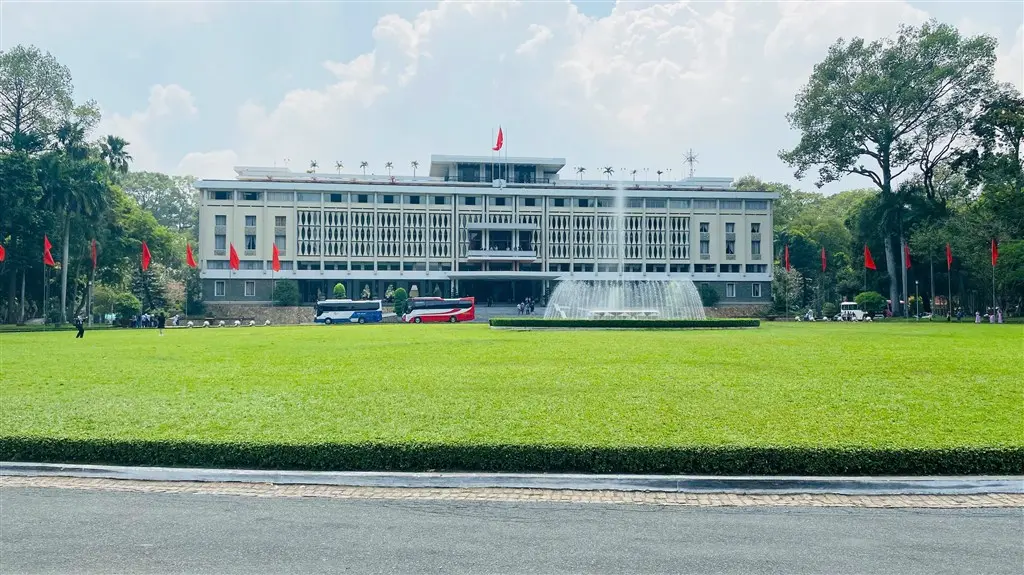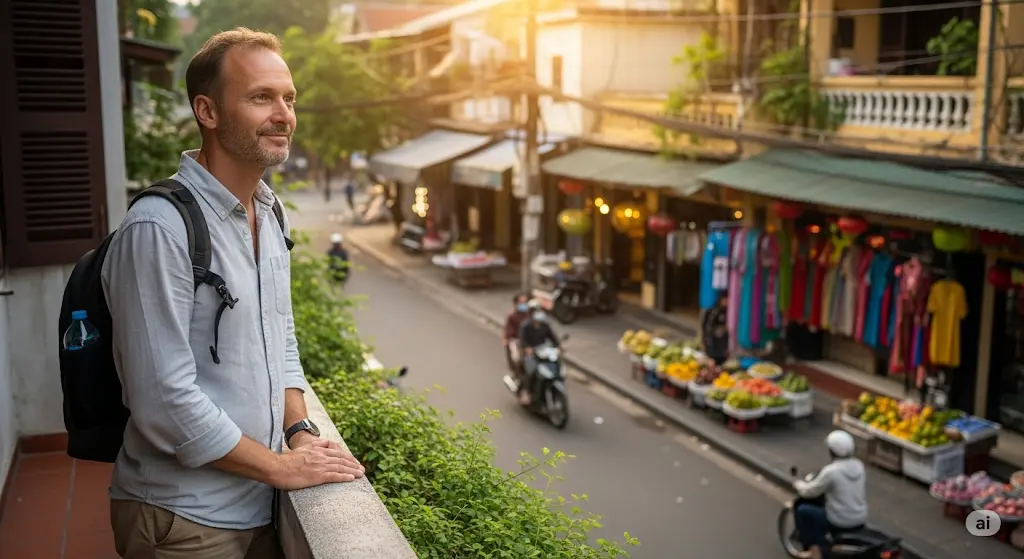The culture of Vietnam is a rich tapestry woven from centuries of history, diverse influences, and a strong sense of identity. It is a cornerstone of Southeast Asian culture and a significant part of Eastern culture. Understanding vietnamese culture is key to appreciating the nation and its people.
This guide from EssentialVietNamtravel.com aims to provide clear insights into the traditions, values, and practices that define this fascinating land. We will explore how history influences traditions and how there is a shared cultural heritage that binds the Vietnamese people. The culture is dynamic, constantly evolving yet deeply rooted in its past.
Planning a Trip to Experience Vietnamese Culture?
Find the best flight deals to Vietnam and start your cultural journey. Compare prices from top airlines to get the most value.
Unveiling Core Vietnamese Traditions and Enduring Customs
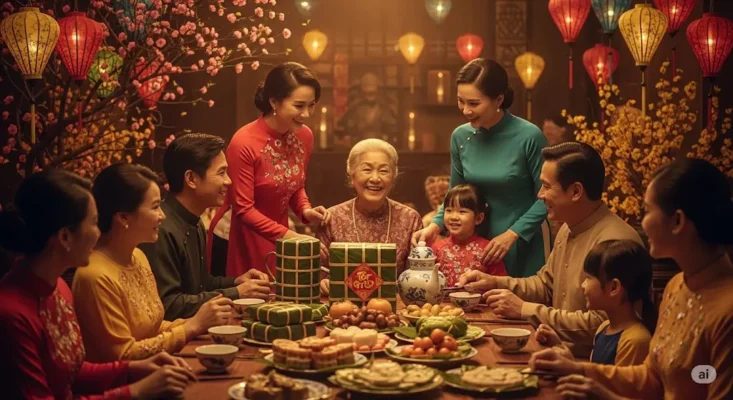
Vietnamese traditions form the bedrock of daily life and societal structure. These customs, passed down through generations, reflect the nation’s history, beliefs, and values. They offer a window into the soul of Vietnam. Observing these practices provides a deeper connection to the culture of vietnamese people. Many traditional vietnamese customs and traditions are evident in everyday interactions and major celebrations.
The vietnamese heritage is rich and diverse, and its customs are an integral part of this. From grand festivals to quiet daily rituals, these traditions shape the vietnamese identity and offer a unique experience for anyone wishing to learn about vietnamese traditions. We believe traditions are important and that vietnamese culture has distinct characteristics. External factors influence culture, but the core remains strong. The tradition and culture of vietnam are deeply intertwined.
Tet Nguyen Dan: The Significance of Lunar New Year
Tet Nguyen Dan, commonly known as Tet, is the most important celebration in vietnamese culture. It marks the Lunar New Year and is a time for family reunions, honoring ancestors, and wishing for good fortune. This major holiday, Tet Nguyen Dan, sees cities quiet down as people travel to their ancestral homes. Preparations for Tet begin weeks in advance. Homes are cleaned thoroughly.
New clothes are purchased. Special holiday foods are prepared, with Banh Chung, a sticky rice cake, being a Tet Holiday special food. During Tet, people visit relatives and temples. They exchange wishes for health and prosperity. Children receive lucky money in red envelopes. The Tet Nguyen Dan celebration is a vibrant display of vietnamese cultural traditions, filled with joy and hope.
It is a prime example of how to experience authentic vietnamese culture firsthand. Understanding this festival is key to understanding vietnam culture traditions. The Lotus flower is a symbolic flower often seen during these times, representing purity and optimism. Bamboo, another key symbol, represents resilience, often used in decorations.
The Importance of Ancestor Veneration in Daily Life
Ancestor veneration is a cornerstone of vietnamese beliefs and rituals. Most Vietnamese homes have an ancestral altar, a sacred space dedicated to deceased family members. This practice reflects deep respect for elders and the belief that ancestors continue to influence the lives of the living. Daily offerings of incense, fruit, and tea are common. On special occasions, such as death anniversaries or Tet, more elaborate offerings and ceremonies take place.
This ritual, ancestor veneration, is not tied to a specific religion but is a widespread cultural practice embodying filial piety. It underscores the importance of family and lineage in vietnamese society. This practice is a significant part of vietnamese customs and demonstrates the enduring connection between generations. Understanding this aspect of vietnamese culture traditions helps in appreciating the depth of family bonds. This respect for elders is a key virtue.
Traditional Attire: The Elegance of the Ao Dai and Other Garments
The Ao Dai is the most iconic traditional dress of Vietnam. This elegant tunic, worn over loose trousers, is a symbol of Vietnamese grace and beauty. While its design has evolved, the Ao Dai unique silhouette remains a powerful cultural emblem. The primary material for a traditional Ao Dai is often silk, enhancing its flowing and delicate appearance.
It is worn by both men and women, though more commonly by women, for special occasions, festivals, and as a uniform in some schools and workplaces. Beyond the Ao Dai, other traditional garments exist, varying by region and ethnic group. The Conical hat, or Non La, is another widely recognized vietnamese culture symbol, practical for farmers and a common sight. These items of clothing are more than just garments; they are expressions of vietnamese heritage and identity. The Ao Dai, in particular, is a salient entity in discussions of vietnam culture.
Common Rituals and Practices in Vietnamese Daily Life
Daily life in Vietnam is interwoven with various rituals and practices that reflect underlying cultural values. Simple greetings often involve a slight bow, especially when addressing elders. The concept of “saving face” is important, influencing communication to be indirect and polite to maintain harmony. Small offerings at local pagodas or temples are common. Belief in karma and the importance of good deeds shape daily actions for many.
Respect for elders is a fundamental vietnamese value, demonstrated in speech and behavior. Even mundane activities, like sharing tea, can be imbued with ritualistic significance, fostering connection and respect. These nuanced social etiquettes are essential facts about vietnamese culture. Understanding these common practices allows for smoother interactions and a deeper appreciation of the traditional culture in vietnam. These vietnam characteristics define daily social fabric.
The Heart of Vietnamese Culture: Family Values and Shaping the Vietnamese Identity
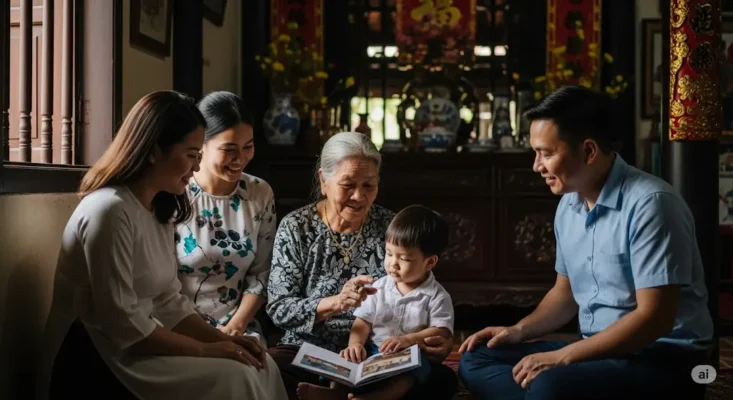
Family is the cornerstone of vietnamese society and a primary shaper of vietnamese identity. The values instilled within the family unit extend to the wider community and national consciousness. The impact of confucianism on vietnamese culture is particularly evident in family structures and the emphasis on collective well-being over individual desires. The family is the key social unit in vietnam culture.
This collective mindset fosters strong bonds and a sense of responsibility towards one another. These family values are not just private matters; they are integral to the culture of vietnam and traditions, influencing everything from business practices to social interactions. The strength of the vietnamese family is often cited as a source of the nation’s resilience. Understanding these unique aspects of vietnamese family culture is essential for anyone seeking to grasp the essence of cultural vietnam.
Understanding Filial Piety and Respect for Elders
Filial piety, or “hiếu thảo,” is a paramount virtue in vietnamese family culture. It encompasses deep respect, obedience, love, and care for one’s parents and elders. This core value, collectivism, is strongly linked to filial piety, as the family’s honor and well-being are prioritized. Children are expected to support their parents in their old age. Decisions are often made with consideration for the entire family.
Respect for elders extends beyond the immediate family to include teachers, seniors in the community, and anyone older. This emphasis on respect for elders is a defining characteristic of vietnamese values. This concept is not merely a social norm but a deeply ingrained ethical principle that guides behavior and relationships. It is a fundamental part of what is the culture of vietnam.
The Collective Nature of Vietnamese Family and Community
Collectivism is a dominant feature of vietnamese society. The interests of the family, community, or group often take precedence over individual desires. This cultural trait fosters a strong sense of interdependence and mutual support. In a traditional vietnamese family, resources are often pooled, and decisions are made collectively. This extends to the wider community, where neighbors help each other, and there is a sense of shared responsibility.
This social principle, harmony, is often achieved through this collective approach. While modernization is introducing more individualistic perspectives, the collective spirit remains a significant aspect of vietnamese culture and traditions. This is one of the key vietnamese features that distinguishes it within the broader Asian culture.
Marriage Customs and Family Structures
Marriage in vietnamese culture is traditionally seen as a union not just between two individuals but between two families. Traditional marriage customs are elaborate, involving several ceremonies, including an engagement ceremony and the wedding itself. Parental approval and involvement are highly valued. Family structure defines social norms, and traditionally, multi-generational households were common, with grandparents, parents, and children living together.
The husband was typically the head of the household, while the wife managed domestic affairs. While these structures are evolving, especially in urban areas, the underlying values of family commitment and respect remain strong. These vietnam culture and traditions surrounding marriage highlight the importance of lineage and community.
How Family Values Contribute to the National Vietnamese Identity
The family values deeply embedded in vietnamese culture play a crucial role in shaping the national vietnamese identity. The emphasis on collectivism, filial piety, respect for elders, and resilience learned within the family unit translates to a broader societal level. These values have helped the Vietnamese people navigate historical challenges and maintain a strong sense of unity and heritage.
The culture of vietnamese people is often characterized by this strong family-centric worldview. This resilience, a key trait of the vietnamese people, is nurtured within the family. The shared cultural heritage is passed down through family stories, traditions, and practices, ensuring that the vietnamese identity remains vibrant and distinct despite external factors influencing culture.
Understanding Vietnamese Society: Key Social Etiquette and Daily Interactions
Navigating vietnamese society requires an awareness of its specific social etiquette. These unwritten rules govern interactions and help maintain harmony, a cherished social principle. Understanding these nuances allows for respectful and positive engagement with local people. From initial greetings to more complex social situations, knowing the appropriate behavior can significantly enhance one’s experience of vietnam culture.
This is especially important as Vietnamese society values politeness and indirectness. Learning these aspects is part of understanding vietnamese traditional ways. EssentialVietNamtravel.com provides this guidance to help you interact confidently and respectfully. The goal is to help you understand vietnamese social etiquette.
Greetings, Introductions, and Forms of Address
Greetings in Vietnam are guided by age and social hierarchy. When meeting someone, a slight bow or nod is customary, especially towards elders or those in higher positions. Handshakes are common, particularly in business settings or with foreigners, but it’s best to wait for the other person, especially a woman, to extend their hand first. Addressing people correctly is important.
Generally, use titles like “Ông” (Mr.), “Bà” (Mrs./Ms. for older/married women), “Cô” (Ms. for younger/unmarried women), or “Anh” (older brother, for a man slightly older), “Chị” (older sister, for a woman slightly older) followed by their first name. Using the vietnamese language correctly in greetings shows respect. For instance, when addressing someone much older, you might use “Bác” (uncle/aunt older than one’s parents). This nuanced social etiquette reflects the respect for elders.
The Nuances of Communication: Indirectness and Harmony
Communication in vietnamese culture often favors indirectness to maintain harmony and avoid causing anyone to “lose face.” Direct confrontation or strong disagreement in public is generally avoided. Instead of a blunt “no,” you might hear a more hesitant or vague response. This is not meant to be evasive but rather polite. Understanding this can prevent misunderstandings.
Listening to what is not said is as important as what is said. Patience and observation are key. The emphasis on harmony means that maintaining a pleasant atmosphere during interactions is prioritized. This is a key aspect of traditional vietnamese culture and societal interactions. This approach helps in maintaining the social principle of harmony.
Gift-Giving Etiquette and Hosting Guests
Gift-giving is a common practice in vietnamese culture, especially when visiting someone’s home or for special occasions. Gifts should be chosen thoughtfully. Items like fruit, sweets, or small tokens from your home country are generally well-received. Avoid giving items like clocks (associated with death), handkerchiefs (sadness), or anything black or white if it’s a celebratory occasion.
Gifts are usually given and received with both hands. It is polite not to open the gift immediately in front of the giver. When invited to someone’s home, arriving on time or slightly late is acceptable. Compliment the home or the food. Taking off your shoes before entering a home is standard practice. These tradition and culture of vietnam customs show respect.
Navigating Public and Private Spaces with Cultural Awareness
Behavior in public and private spaces in Vietnam requires cultural sensitivity. In temples or pagodas, dress modestly (cover shoulders and knees) and speak softly. Remove your shoes before entering the main prayer area. Public displays of affection are generally not common.
When taking photos, always be respectful, especially of people; ask for permission if you are unsure. In markets, bargaining is expected, but it should be done with a friendly attitude. In private homes, observe the lead of your host. These cultural facts about vietnam help in showing respect for local customs. Understanding these distinctions between public and private behavior demonstrates an appreciation for the culture in vietnam.
Celebrating Together: A Journey Through Vibrant Vietnamese Festivals and Cultural Events
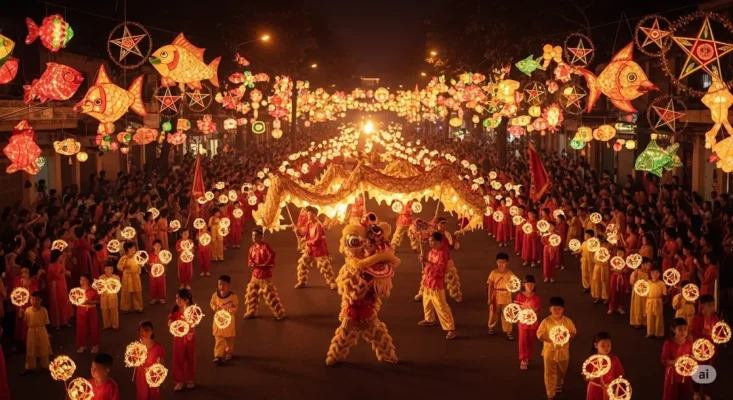
Vietnamese festivals are a vibrant expression of the nation’s culture, heritage, and community spirit. These celebrations, ranging from solemn remembrances to joyous gatherings, offer a unique opportunity to experience authentic vietnamese culture. Festivals in Vietnam often involve colorful processions, traditional music and dance, special foods, and religious ceremonies.
They serve the purpose of community bonding and reaffirming cultural identity. Attending such events allows one to find vietnamese cultural events and witness vietnam culture traditions firsthand. Each festival tells a story, reflecting local legends, historical events, or agricultural cycles. EssentialVietNamtravel.com encourages travelers to seek out these experiences.
Major National Festivals Beyond Tet
While Tet Nguyen Dan is the most significant, Vietnam celebrates several other important national festivals. The Hung Kings’ Commemoration Day (usually in April) honors the legendary founders of the nation. It is a day of national pride and pilgrimage to the Hung Temple in Phu Tho province. The Mid-Autumn Festival (Tết Trung Thu), celebrated on the 15th day of the 8th lunar month, is a delightful festival, especially for children.
It features lion dances, lantern parades, and the sharing of mooncakes. National Day on September 2nd commemorates the declaration of independence. These vietnamese festivals are deeply rooted in vietnamese history and tradition, offering profound insights into the culture.
Regional Celebrations and Their Unique Characteristics
Beyond national holidays, Vietnam boasts a rich tapestry of regional celebrations, each with its own specific regional folklores and unique characteristics. The Hue Festival, held biennially in the former imperial capital, showcases traditional arts, music, and royal court ceremonies. The Da Lat Flower Festival transforms the highland city into a floral wonderland.
In the Mekong Delta, river-based festivals celebrate the region’s close connection to water. Mountainous regions have their own distinct festivals tied to ethnic minority groups and their unique customs. Exploring these regional events offers a deeper understanding of the diverse cultural vietnam landscape and the vietnamese traditions specific to different areas.
The Role of Folk Performances and Games in Festivals
Folk performances and traditional games are integral to many vietnamese festivals. Water puppetry, a unique vietnamese art form, often features prominently, with puppets dancing on water, telling stories of rural life and legends. The origins of water puppet theater are ancient and fascinating. Dragon dances and lion dances, accompanied by lively drumming, are common, believed to bring good luck and ward off evil spirits. Traditional games like “đánh đu” (bamboo swings), human chess, and tug-of-war foster community spirit and add to the festive atmosphere. These traditional art forms and games are a vital part of vietnamese culture and traditions.
Experiencing Vietnamese Festivals as a Visitor
Experiencing a vietnamese festival can be a highlight of any trip to Vietnam. To do so respectfully and enjoyably, plan ahead. Check festival dates, as many follow the lunar calendar. Dress modestly, especially if the festival involves religious sites. Be open to trying new foods and observing local customs. Ask for permission before taking photos of people or ceremonies. While it’s exciting, remember these are important cultural events for locals, so maintain a respectful demeanor. Engaging with festivals is an excellent way how to experience authentic vietnamese culture. It allows you to learn about vietnamese traditions directly from the source.
A Taste of Vietnam: Exploring the Richness of Vietnamese Cuisine and its Cultural Importance
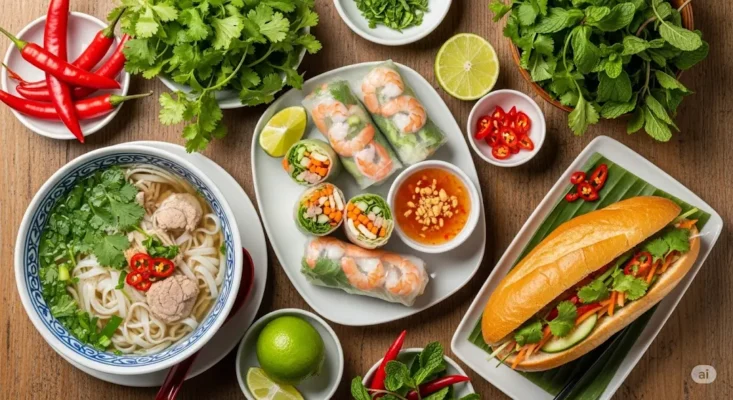
Vietnamese cuisine is renowned worldwide for its fresh ingredients, delicate flavors, and artful presentation. It is a vital aspect of vietnamese culture, reflecting the country’s agricultural abundance, regional diversity, and philosophical principles. Food in Vietnam is more than sustenance; it is a social event, a way to express hospitality, and a connection to heritage.
Many traditional vietnamese customs and traditions are centered around food preparation and sharing. The staple food is rice, forming the base of most meals. Exploring vietnamese cuisine offers a delicious pathway to understanding the culture of vietnam. You can experience vietnamese cuisine in many ways, from street food stalls to family meals.
Iconic Dishes: Beyond Pho and Banh Mi
While Pho, the famous noodle soup, and Banh Mi, the Vietnamese baguette sandwich, are internationally celebrated, vietnamese cuisine offers a much wider array of iconic dishes. Bun Cha (grilled pork with rice vermicelli), particularly famous in Hanoi, is a must-try. Cao Lau, a unique noodle dish from Hoi An, features distinctive noodles, pork, and local greens.
Com Tam (broken rice) served with grilled pork ribs, shredded pork skin, and a steamed egg cake is a southern favorite. Goi Cuon (fresh spring rolls) are a light and healthy option. Exploring these dishes provides a deeper appreciation for vietnam traditional foods. Each dish tells a story of its region and the culture in vietnamese culinary arts.
Regional Culinary Variations from North to South
Vietnamese cuisine exhibits distinct regional variations, influenced by climate, geography, and local ingredients. Northern cuisine, centered around Hanoi, tends to be more savory and subtle in its flavors, with classic dishes like Pho and Bun Cha. Central Vietnamese cuisine, especially from Hue, is known for its spiciness and intricate, often royal, presentation. Southern cuisine, influenced by the fertile Mekong Delta, is often sweeter and uses more herbs, coconut milk, and seafood. Understanding these regional differences highlights the diversity within the culture of vietnam and traditions related to food. Geography impacts regional customs, especially in cooking.
The Philosophy of Balance in Vietnamese Cooking
A key philosophy in vietnamese cooking is the balance of “âm dương” (yin and yang) and the five elements (wood, fire, earth, metal, water), corresponding to five flavors (sour, bitter, sweet, spicy, salty) and five colors. This pursuit of harmony is evident in the way ingredients are combined to create dishes that are not only delicious but also considered beneficial for health. Fresh herbs, vegetables, and a light touch with fats contribute to this balance. This approach reflects a deep connection to nature and a holistic view of well-being, central to vietnamese features in its culinary arts. This pursuit of harmony is a core value in broader vietnamese culture.
Mealtime Etiquette and the Social Aspect of Eating
Meals in Vietnam are typically communal affairs, with dishes shared by everyone at the table. Rice is served in individual bowls, while other dishes are placed in the center. Use chopsticks for most foods. When not using them, rest them on a chopstick rest or across your rice bowl, but never stick them vertically into the rice bowl (resembles incense for the dead). It is polite to try a little of everything. Elders are often served first.
Complimenting the cook is appreciated. Understanding this mealtime etiquette helps in enjoying the social aspect of eating, which is a significant part of vietnamese customs. Learning these customs helps one to learn about vietnamese traditions surrounding food.
Echoes of the Past: How Vietnamese History and Heritage Shape its Art, Music, and Beliefs Today

The long and complex vietnamese history is a powerful force that continues to shape its contemporary culture, arts, music, and belief systems. From ancient Dong Son culture to periods of Chinese rule, French colonization, and the struggles for independence, each era has left an indelible mark. This resilience against foreign influence is a unique characteristic of vietnamese culture.
The vietnamese heritage is a testament to this ability to absorb, adapt, and yet maintain a distinct identity. Understanding this historical context is crucial to appreciating the depth and nuances of current cultural expressions in Vietnam. The fusion of Confucianism-Buddhism-Taoism, for example, is a direct result of these historical interactions. History influences traditions significantly.
Key Historical Periods and Their Cultural Impact
Several key historical periods have profoundly shaped vietnamese culture. Over a thousand years of Chinese rule introduced Confucianism, which became a cornerstone of the social and political order, influencing family structure and ethics. The impact of confucianism on vietnamese culture is still palpable today. The Ly and Tran dynasties saw a flourishing of Buddhism and uniquely Vietnamese arts.
French colonization in the 19th and 20th centuries brought Western influences in architecture, cuisine, and language, and this significant period also fueled a strong nationalist movement. The wars of the 20th century further forged a spirit of resilience and national unity. This vietnamese history, marked by both foreign influence and strong internal development, created a rich, layered culture.
Traditional Vietnamese Art Forms: Lacquerware, Silk Painting, and Calligraphy
Vietnamese art is diverse and expressive, with several traditional forms holding significant cultural value. Lacquerware (sơn mài) is a highly developed craft, involving intricate processes of applying layers of lacquer from the son tree, often inlaid with mother-of-pearl or eggshells, to create stunning pieces. Intricate lacquerware techniques have been passed down for generations.
Silk painting (tranh lụa) is another cherished art form, known for its soft, mystical qualities and depiction of landscapes, daily life, and historical scenes. Calligraphy (thư pháp), using Chinese-like characters (Chữ Nôm or Hanzi) or the modern Vietnamese script (Chữ Quốc Ngữ), is practiced as an art, especially during Tet, to create auspicious messages. These arts and crafts are vital parts of vietnamese heritage.
The Sounds of Vietnam: Exploring Traditional Vietnamese Music and Instruments
Traditional vietnamese music is rich and varied, reflecting regional differences and historical influences. Nhã nhạc, or Vietnamese court music, recognized by UNESCO, is an elegant and ceremonial form. Ca trù is a sophisticated chamber music featuring a female vocalist. Quan họ, folk songs from Bac Ninh province, are known for their call-and-response patterns between male and female singers.
The Dan Bau, a monochord zither, is a unique traditional instrument capable of producing evocative, voice-like tones. The complex tonal language influence on music is evident in the melodic structures. Exploring vietnamese music provides a deep connection to the cultural soul of Vietnam. Water puppet theater origins are also linked to rural folk traditions and music.
Dominant Belief Systems: Confucianism, Buddhism, Taoism, and Folk Religions in Vietnam
Vietnamese spiritual life is characterized by a harmonious blend of several belief systems. Confucianism, with its emphasis on social order, filial piety, and education, has deeply shaped vietnamese society and ethics. Buddhism is widely practiced, with many pagodas across the country serving as centers for worship and community life.
Taoism has contributed philosophical ideas about harmony with nature and living a simple life. Alongside these, indigenous folk religions, including the veneration of local deities, nature spirits, and national heroes, remain prevalent. This fusion of Confucianism-Buddhism-Taoism, along with folk beliefs, creates a unique spiritual landscape where religious beliefs shape ethics and daily practices. This is a key aspect of what is the culture of vietnam.
Further Reading: Explore More of Vietnam
EssentialVietNamtravel.com hopes this guide provides a valuable starting point for your journey into the heart of vietnamese culture. By understanding its traditions, values, and social nuances, you can engage more deeply and respectfully with this beautiful country and its resilient people. The culture is dynamic, and while traditions are important, it continues to evolve, making every encounter a unique discovery within the broader human civilization.

